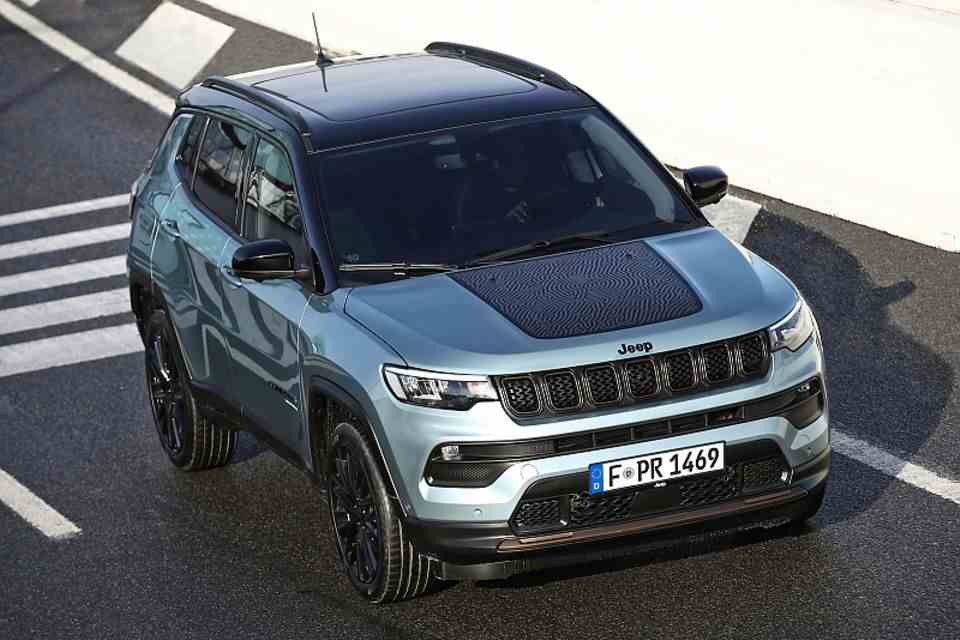Jeep Compass e-Hybrid
Inner cleaning
Jeep Compass e-Hybrid
© press-inform – the press office
In the next two years, Jeep wants to become a pure electric brand. The Compass / Renegade 4xe plug-in models are now being joined by their mild hybrid siblings and soon the Grand Cherokee, which is already available in the US and will come to Europe only as a plug-in variant.
Who could have imagined that a few years ago? In just a few months there will be no Jeep in Germany that does not have at least a partially electrified drive train. Antonella Bruno, Head of Jeep Brand Europe: “The electrification plan that we started in late 2020 with the introduction of 4xe plug-in hybrid technology for the Compass and Renegade SUVs and later for the Wrangler is now evolving with the Compass and Renegade e-Hybrid, which will be followed by the new Grand Cherokee, which will only be available as a plug-in hybrid, and our first 100 percent electric SUV in early 2023.”
Two cars – the same technology? Not quite, because the Jeep Renegade conveys a more rustic image, the Compass a more urban image, although in practice the two frolic at best in the jungle of city traffic, with hardly any detours into the terrain, for which both have better abilities than some competitors. The new Jeep Compass enjoys better interior soundproofing and an updated interior, having undergone a facelift compared to the Renegade in the middle of last year. Dashboard and door panels are of better quality with their softer surfaces, glove box or door pockets are larger in size and there are direct ventilation openings for the rear seats. In addition, the design of the dashboard has changed completely: it now features a larger, higher-positioned screen of the multimedia system and the instrumentation changes from a largely analogue to a digital 10.25-inch screen. According to Jeep, the multimedia system uses a processor five times faster than the previous model and the data is displayed on an 8.4- or 10.1-inch touchscreen, depending on the version, which also reflects Android Auto and Apple CarPlay if desired.
The Compass, 16 centimeters longer than the Renegade, has a longer wheelbase, which means more rear legroom, where passengers sit higher than in the front seats, and a 90-liter larger trunk (438 litres). Hardly any new petrol engines are available these days, but the Compass e-Hybrid does feature a newly developed powertrain, albeit derived from an existing FCA powertrain. “We took the 1.3 liter petrol engine and increased both the bore and the stroke of the cylinders to get to this 1.5 displacement, designed a new cylinder head, increased the injection pressure (from 250 to 350 bar) and at the same time changed the duty cycle to Miller, since the typical delayed closing of the valves and the high compression ratio – 12.5:1 – benefit efficiency, which is a priority here,” explains chief engineer Marco Montaldo. As usual, the Miller cycle has a negative effect on performance, so it is not surprising that the 1.5-cylinder turbo engine only has a peak power of 96 kW / 130 hp as before and the maximum torque with 240 instead of 270 previously Nm is even lower. The powerplant is mated to a new seven-speed Getrag dual-clutch transmission, which uses a wet start-up clutch and is noticeably more responsive, which is particularly noticeable during downshifts and kickdown. A 48 volt electric motor with 15 kW / 22 hp / 135 Nm is integrated into the gearbox and the hybrid system is powered by a water-cooled 0.8 kWh 48 volt battery with a DC/DC converter from 48 to 12 Volt and a belt starter generator for smooth restarting of the engine at low speeds.
The first test drive in and around Turin ended with a consumption of 8.1 liters / 100 km, which is well above the promised WLTP value of 5.7 to 6.1 liters, which is 15 percent less than the consumption of the previous one would be incinerator. The infotainment menu showed that eight of the total of 51 kilometers were driven purely electrically. The additional boost not only helps at the start, but also during intermediate sprints, because the 4.40 meter long Compass e-Hybrid effortlessly gains speed from 1,600 rpm, even if you shouldn’t expect a strong boost. 10.0 seconds from a standstill to 100 km/h are hardly faster than before and far from what the plug-in hybrid is capable of with 7.9 seconds. After all, 130 hp are the lower end of the drive range for a 1.6-ton crossover anyway. The top speed: a good 193 km/h.
The steering is very light – but offers an acceptable feeling with 2.6 wheel revolutions. And you can’t change that, because the e-Hybrid Compass doesn’t have any driving modes that nobody misses anyway. The independent suspension is a bit awkward on uneven ground; but has the advantage that it makes the Compass a stable compact SUV with the help of the 255/55-R18 tires. The Jeep Compass e-Hybrid (and Renegade e-Hybrid) will be available from this spring in three trim levels (Limited, Upload and S) with prices starting at €39,600, a €4,500 cost advantage over the 190hp plug-in -Hybrids of the Jeep Compass 4xe means, which, however, is tax-deductible. Also because the useful all-wheel drive is missing in the Compass e-Hybrid, the plug-in hybrid should therefore be the much more interesting variant for most customers.


